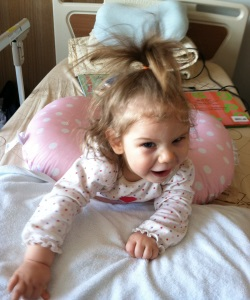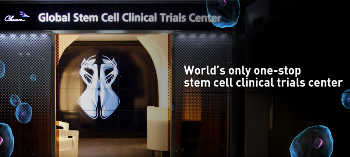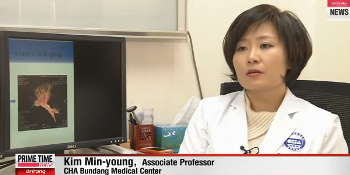You are here
First US patient treated in South Korea for Cerebral Palsy
 Nina and Zach Miller were the first parents from the United States to take their daughter Josephine, who has cerebral palsy, to South Korea for therapy with donated cord blood.
Nina and Zach Miller were the first parents from the United States to take their daughter Josephine, who has cerebral palsy, to South Korea for therapy with donated cord blood.
Theirs is not another story about parents seeking an unproven stem cell therapy - perhaps with stem cells of uncertain provenance - at a for-profit overseas clinic. The Millers traveled to an established medical research center, the CHA Bundang Medical Center in Seoul S. Korea, to participate in a registered clinical trial led by MinYoung Kim, MD PhD.
Josephine is the Miller's first child and she has cerebral palsy. As an infant, Josephine could barely sleep for more than 2 hours at a time. She could not take any food by mouth and had to survive on feedings delivered via a G-tube surgically implanted into her stomach.
Desperate to ameliorate Josephine's cerebral palsy, the Millers researched all their options in stem cell therapy. Based on publications in the medical literature and anecdotes from other parents who had tried stem cell therapy, the Millers concluded that cord blood stem cells held the most promise. But Josephine's cord blood had not been saved.
The question became, was there any way to get cerebral palsy therapy for Josephine with stem cells from donated cord blood? In the US, our FDA has not approved donated stem cells for use in children who have brain injuries like cerebral palsy. The FDA has approved several clinical trials in which children receive their own stem cells as therapy for brain injury. To date about 400 children who have brain injuries and have their own cord blood stored have been treated in US clinical trials. But no child has received donated cord blood for cerebral palsy in the US (except for one borderline case of an identical twin).
For those US families that have a child with a brain injury and who did not save their child's cord blood, access to stem cell therapy has remained elusive. An industry of for-profit clinics has popped up outside US borders to offer "stem cell therapy" to this community. But since none of these clinics holds an accreditation in cord blood banking, nor has a known relationship with an accredited cord blood bank, it is hard to know what exactly they are infusing into their patients. Do they really provide cord blood stem cells? Did the donating mothers give informed consent, and were they screened for infectious diseases? Questions abound. The Millers did not want to go down that route, they wanted to work with a research center that has rigorously supervised laboratory conditions.
Meanwhile, the CHA Bundang Medical Center, in Seoul S. Korea, has been running a series of clinical trials to treat children with cerebral palsy. In 2012 they published the world's first proof that cerebral palsy treatment with donated cord blood has efficacy. A follow-up trial on 300 patients has been submitted for publication. Korean TV has followed the trials on Arirang News.
Nina Miller contacted Dr. MinYoung Kim, the lead investigator of the cerebral palsy trials in Seoul. The team at CHA Bundang Medical Center was willing to accept Josephine into their program.
There was just one catch: Josephine needed to find a matching cord blood unit for the therapy. Josephine is not of Asian heritage and the Korean banks did not have a cord blood unit that was a close enough match for her. Her doctors initiated a search of the international registry, BMDW, and found that Josephine had four matches around the world, including three units in three US public cord blood banks.
Getting one of those matching units for Josephine proved to be surprisingly difficult, and revealed that the NMDP network of public cord blood banks is not ready to handle an influx of patients who seek donor cord blood for regenerative medicine. Roughly half of the cord blood transplants facilitated by the NMDP involve a patient and donor located in different countries; they are very experienced with international transplants, including transplants under clinical trials. But because Josephine's case was a request to use cord blood for regenerative therapy (not a traditional transplant), the NMDP classified her request as "research use", and this passed the responsibility for handling the request to the individual banks that held the cord blood units. The first two US public banks that were approached refused to release their matching cord blood unit to Josephine.
Fortunately, a third matching cord blood unit was in the Cleveland Cord Blood Center, and they decided to release their unit to Josephine as a case of "compassionate use". In making this decision, the bank gave careful consideration to its intended use in a controlled clinical trial, at an established bona-fide research institution.
The Miller's challenges were still not over, because there was still a financial hurdle to surmount. Public cord blood banks routinely charge about $30,000 to release one of their units. When the cord blood is required for a transplant, that cost is covered by the patient's health insurance. But the Millers did not have insurance coverage to participate in a clinical trial in a foreign country. They were looking at a $30,000 out of pocket cost to obtain a matching cord blood unit for their child's therapy.
Once again, compassionate strangers came to the rescue, and a philanthropic foundation covered most of the cost of Josephine's matching cord blood unit.

Finally, in Feb. 2014 the Miller family made the 17 hour plane trip to Seoul with Josephine. Their airfare alone cost thousands of dollars. Upon arrival they found that the CHA University hospital had built a beautiful clinic, the Chaum Global Stem Cell Clinical Trials Center, to accommodate patients who travel to S. Korea from other nations.
The protocol for cerebral palsy treatment at CHA Bundang Medical Center consists of immune suppression with cyclosporine followed by peripheral infusion of the donor stem cells. Prior to the infusion, Josephine underwent numerous tests of her baseline skills and a PET scan of her brain. Because she was taking immune-suppressing drugs to prevent rejection of the donor stem cells, Josephine had to stay in the hospital for three weeks.
The Millers felt that "the best part of Korea was the physical therapy and the therapists". Whereas children in the US who have cerebral palsy may receive physical therapy once or twice a week, during their stay at CHA University Josephine received multiple half hour sessions of therapy every day, adding up to about 3 hours of therapy per day. The sessions included physical therapy (PT), occupational therapy (OT), electric stimulation, and optional stimulation with art and music.
The PT at CHA University emphasizes building from fundamental skills. Every day, each patient spends a great deal of time simply loosening muscles with stretching and electric stimulation. Therapists focus primarily on developing correct posture and core muscle strength. The therapy relentlessly repeats the muscle relaxation and basic skills before moving on to specific skills.
The Millers paid $25,000 in advance to cover Josephine's treatment in S. Korea. This covered the stem cell infusion, immune-suppressing drugs and other medications, the hospital room, the family's accommodations, and the many hours of PT over the course of three weeks.
On the way home from S. Korea, Josephine caught a bad bronchial infection and ended up on antibiotics. This illustrates the risks involved in traveling long distance for a therapy that requires immune suppression. Since coming home, the Millers have continued to work with Josephine daily using the PT techniques that they learned in S. Korea.
Josephine has made the following advances over the nine months since her cord blood therapy in S. Korea: Ever since she was a baby, Josephine had chronic reflux, threw up 10-15 times per day, and was fed with a G-tube. Once she had the therapy, her reflux completely disappeared and within four weeks she began drinking milk from a cup. She still uses the G-tube for other foods. When Josephine went to S. Korea at age 19 months, her hands were always balled into fists, she could not roll over, and she could not sit without support. Within five weeks she learned to roll over. Now she can use her hands to grasp and she can maintain a sitting position for a half hour to an hour, depending on whether she is having a good day.
This story is one family's experience and is not an endorsement or indictment of any of the institutions involved. It is important to tell the Millers' story because it poignantly illustrates the issues that are currently involved in delivering stem cell therapy as a treatment for brain injury at birth.
First, families who have children with neurologic disorders should appreciate the difference between the services offered by a for-profit "stem cell clinic" versus a hospital research center. The International Society for Stem Cell Research (ISSCR) has developed resources for patients considering stem cell therapy. They have a website titled a closer look at STEM CELL treatments that is full of helpful information, and their main website has a link to download a patient handbook.
Second, researchers who are designing clinical trials to treat children with cerebral palsy and other neurologic disorders should take into account that patients in the S. Korea trials receive very intensive physical therapy. When comparing the outcomes of clinical trials, using the same stem cell sources, differences in the simultaneous PT must be taken into consideration.
Third, both individual public cord blood banks and national networks of public banks around the world should establish committees and protocols for handling requests on behalf of patients who seek a matching cord blood unit for cerebral palsy therapy or other regenerative medicine therapy. Formal procedures would help ensure that these decisions are carefully weighed, that there is a record of the request and the decision, and that the decision is not unduly influenced by any personal bias or conflict of interest.
Fourth, increasing use of donor cord blood for cerebral palsy therapy could be good news for public cord blood banks. The GAO has issued a report that documents the failure of public cord blood banks in the US to attain financial self-sufficiency. Releasing allogeneic cord blood units for cerebral palsy therapy could be the financial salvation of public cord blood banks, especially since this therapy could use the older bank inventory of smaller cord blood units that are less desirable for transplants.



